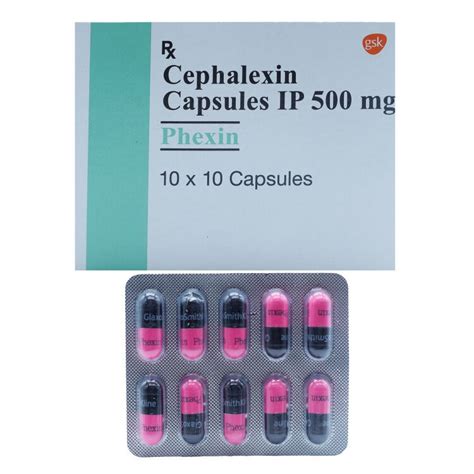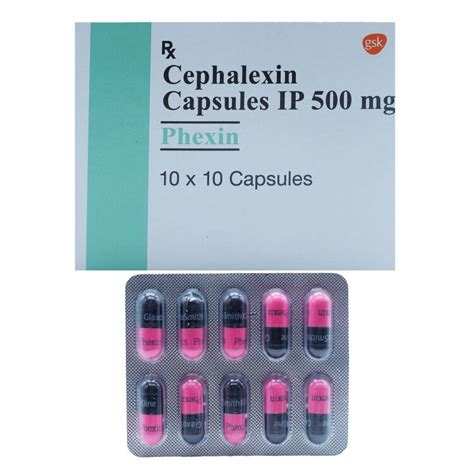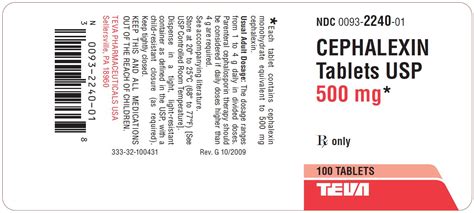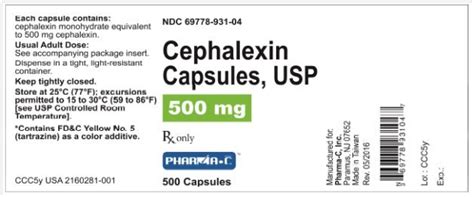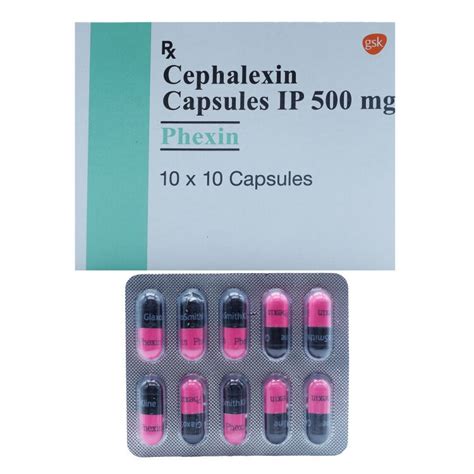Cephalexin 500mg is a widely prescribed antibiotic that belongs to the cephalosporin class of medications. It is used to treat various bacterial infections, including those affecting the skin, respiratory tract, and urinary tract. Understanding the key facts about Cephalexin 500mg can help individuals make informed decisions about their health and ensure they use the medication effectively and safely.
The importance of antibiotics like Cephalexin 500mg cannot be overstated, as they play a critical role in combating bacterial infections that can otherwise lead to severe health complications. With the rise of antibiotic resistance, it is more crucial than ever to use these medications judiciously and under the guidance of a healthcare professional. This article aims to delve into the specifics of Cephalexin 500mg, exploring its uses, side effects, dosage, and other essential information that patients should know.
Cephalexin 500mg is one of the many dosage forms available for this antibiotic, and its selection depends on the severity of the infection, the patient's age, weight, and renal function. The medication works by inhibiting the synthesis of the bacterial cell wall, leading to the death of the bacteria. This mechanism of action is effective against a broad spectrum of Gram-positive and some Gram-negative bacteria, making Cephalexin 500mg a versatile treatment option for various infections.
Introduction to Cephalexin 500mg
Cephalexin 500mg is an oral antibiotic that is commonly prescribed for the treatment of bacterial infections. It is a first-generation cephalosporin, which means it is effective against a wide range of bacteria but has limited activity against bacteria that produce beta-lactamase enzymes. The medication is available in capsule or tablet form and is usually taken with food to enhance absorption and reduce gastrointestinal side effects.
Uses of Cephalexin 500mg
Cephalexin 500mg is indicated for the treatment of various bacterial infections, including:
- Skin and soft tissue infections
- Respiratory tract infections, such as pneumonia and bronchitis
- Urinary tract infections, including cystitis and pyelonephritis
- Bone and joint infections
The medication is effective against infections caused by susceptible strains of bacteria, and its use should be guided by culture and susceptibility testing whenever possible.
Side Effects of Cephalexin 500mg
Like all medications, Cephalexin 500mg can cause side effects, some of which are more common than others. The most frequently reported side effects include:
- Diarrhea
- Nausea and vomiting
- Abdominal pain
- Headache
- Dizziness
- Rash
Severe side effects are less common but can include allergic reactions, Stevens-Johnson syndrome, and Clostridioides difficile-associated diarrhea. Patients should report any side effects to their healthcare provider, especially if they are severe or persistent.
Dosage and Administration of Cephalexin 500mg
The dosage of Cephalexin 500mg varies depending on the type and severity of the infection. Typical dosages range from 250mg to 500mg, taken every 6 to 12 hours. The medication should be taken for the full prescribed duration, even if symptoms improve before completing the course, to ensure that the infection is fully cleared and to reduce the risk of resistance development.
Interactions with Other Medications
Cephalexin 500mg can interact with other medications, including:
- Metformin, used for diabetes treatment
- Probenecid, used for gout treatment
- Warfarin, an anticoagulant
These interactions can either increase the risk of side effects or affect the efficacy of Cephalexin 500mg. Patients should inform their healthcare provider about all medications they are taking before starting Cephalexin 500mg.
Precautions and Warnings
Cephalexin 500mg is generally well-tolerated, but there are certain precautions and warnings to be aware of:
- Allergic reactions: Patients with a history of allergy to cephalosporins or penicillins should use Cephalexin 500mg with caution.
- Renal impairment: Dosage adjustments may be necessary in patients with renal impairment.
- Pregnancy and breastfeeding: Cephalexin 500mg should be used during pregnancy and breastfeeding only if clearly needed, under the guidance of a healthcare provider.
Benefits of Cephalexin 500mg
The benefits of Cephalexin 500mg include:
- Effective treatment of bacterial infections
- Broad spectrum of activity
- Oral administration, making it convenient for outpatient treatment
- Generally well-tolerated, with a favorable side effect profile
Conclusion and Final Thoughts
In conclusion, Cephalexin 500mg is a valuable antibiotic for the treatment of various bacterial infections. Its effectiveness, combined with its relatively favorable side effect profile, makes it a commonly prescribed medication. However, it is essential to use Cephalexin 500mg judiciously and under the guidance of a healthcare professional to minimize the risk of side effects and the development of antibiotic resistance.
We encourage readers to share their experiences or ask questions about Cephalexin 500mg in the comments below. If you found this article informative, please consider sharing it with others who might benefit from this information. Your engagement helps us create more relevant and useful content for our readers.
What is Cephalexin 500mg used for?
+
Cephalexin 500mg is used for the treatment of various bacterial infections, including skin and soft tissue infections, respiratory tract infections, urinary tract infections, and bone and joint infections.
How should I take Cephalexin 500mg?
+
Cephalexin 500mg should be taken orally, with food, to enhance absorption and reduce gastrointestinal side effects. The dosage and duration of treatment should be as prescribed by a healthcare provider.
Can I take Cephalexin 500mg if I am allergic to penicillins?
+
Cephalexin 500mg should be used with caution in patients with a history of allergy to cephalosporins or penicillins. It is essential to consult a healthcare provider before taking the medication.
